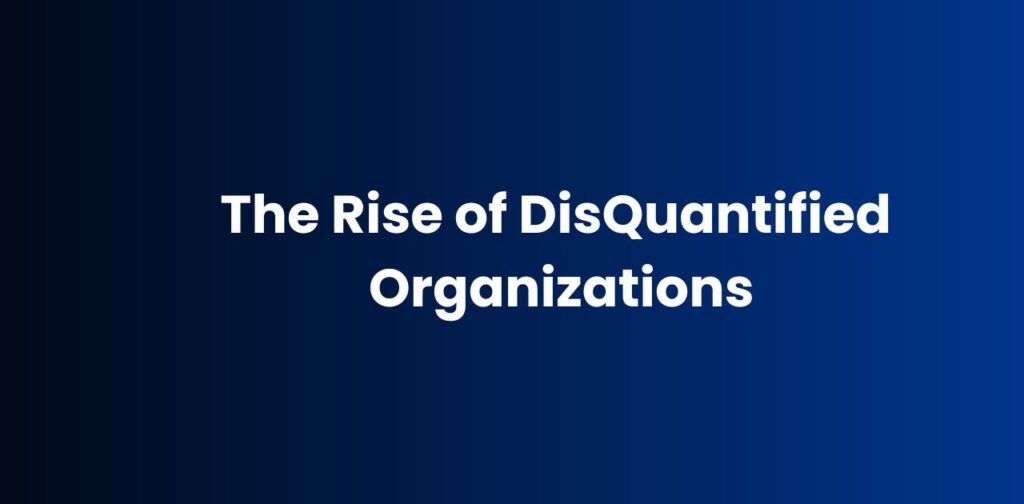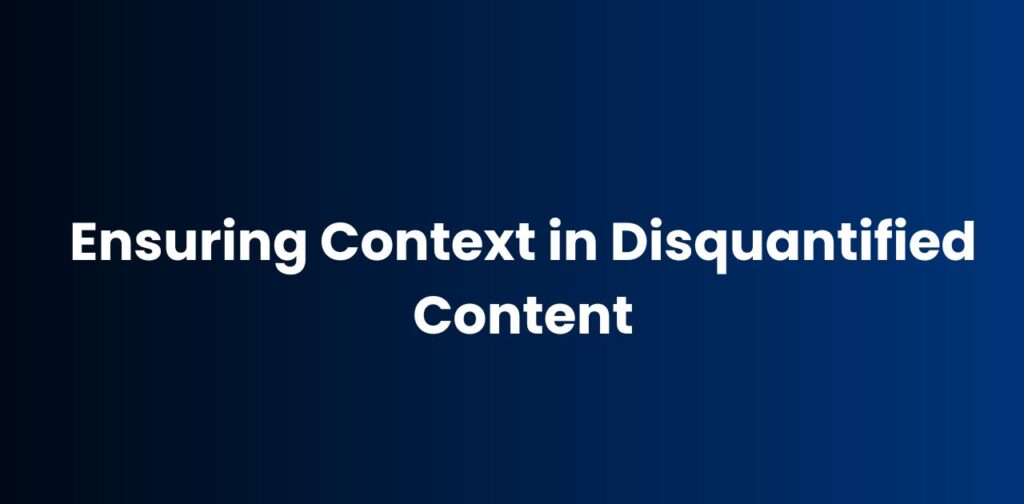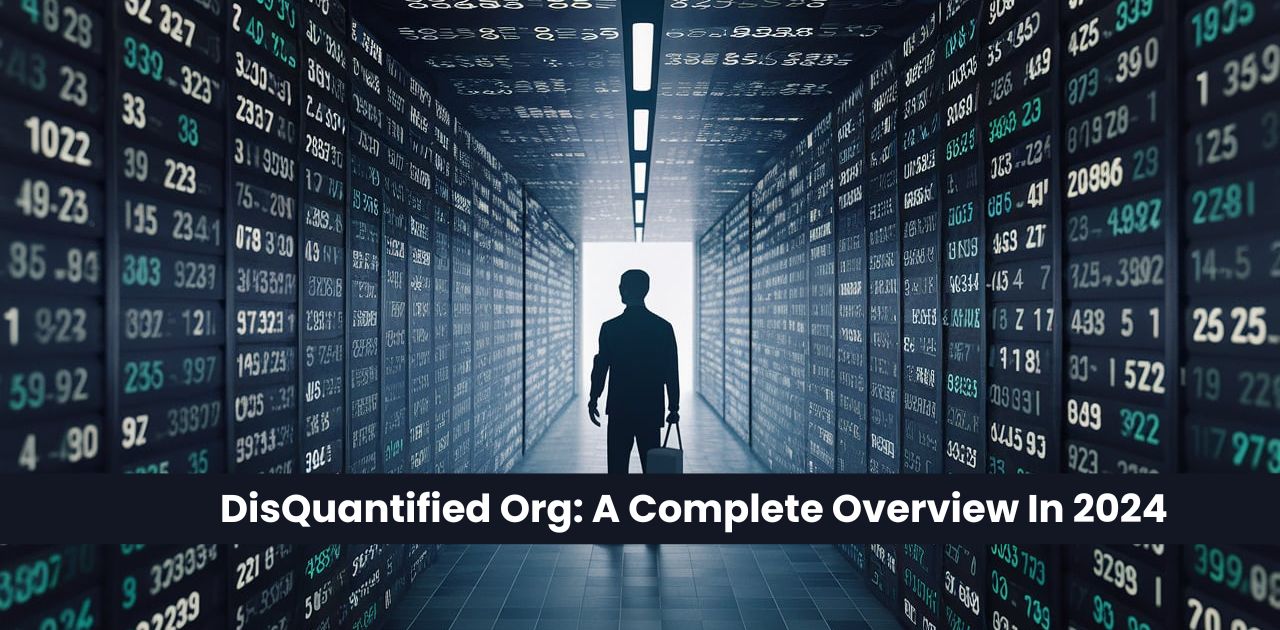Ever feel overwhelmed by numbers and data? You’re not alone. In 2024, we’re drowning in information, but what happens when that data loses its meaning?
Enter DisQuantified Org. It’s all about understanding and dealing with “disquantification” the process where data loses its precision and becomes less measurable.
This overview will break down:
- What disquantification really means
- How it impacts businesses and everyday life
- Why some organizations are embracing it
- Practical ways to handle disquantified data
Whether you’re a business owner, data enthusiast, or just curious, this guide will help you navigate the complex world of disquantification. Ready to make sense of the numbers? Let’s dive in!
What is Disquantification?
Imagine you’re trying to measure your fitness progress, but instead of tracking specific metrics like weight or running time, you’re left with vague statements like “feeling healthier” or “clothes fitting better.” That’s disquantification in a nutshell.
Disquantification refers to the process of degrading data quality and reliability, often leading to a loss of measurable attributes. It’s not just about missing data; it’s about information that loses its precision and becomes less quantifiable.
But why does this matter? In a world where “data is king,” disquantified information can lead to misguided decisions, flawed strategies, and missed opportunities. Whether you’re a business owner, a marketer, or just someone trying to make informed choices, understanding disquantification is crucial.
The Impact on Data Accuracy
Let’s face it: we all rely on accurate data to make decisions. But what happens when that data becomes disquantified? The consequences can be far-reaching and sometimes devastating.
Consider this: A company bases its entire marketing strategy on customer satisfaction scores. But if these scores become disquantified perhaps through vague survey questions or inconsistent measurement methods the resulting strategy could be built on a shaky foundation.
The impact of disquantification on data accuracy isn’t limited to business. It affects everything from scientific research to personal finance. When data loses its precision, it’s like trying to navigate with a broken compass. You might think you’re heading in the right direction, but you could be way off course.
The Rise of DisQuantified Organizations

Now, here’s where things get interesting. Some organizations are embracing disquantification as a way to move beyond rigid metrics and focus on more holistic, human-centered approaches.
These “disquantified organizations” prioritize qualitative measures over purely quantitative ones. They’re asking: How can we measure employee well-being beyond just productivity numbers? How can we assess customer satisfaction beyond simple ratings?
Take Zappos, for example. Instead of focusing solely on call times, they emphasize the quality of customer interactions. It’s a shift from “how many” to “how well.”
But it’s not all sunshine and rainbows. Implementing a disquantified approach comes with its own set of challenges. How do you measure success when traditional metrics are set aside? How do you convince stakeholders of your progress?
How to Implement DisQuantified Org in your Organization
Thinking of embracing disquantification in your organization? Here’s a roadmap to get you started:
- Reassess your KPIs: Are they truly measuring what matters?
- Foster a culture of trust: Empower employees to make decisions based on qualitative insights.
- Invest in soft skills: Train your team to interpret and act on non-quantifiable data.
- Embrace feedback loops: Encourage continuous, qualitative feedback from all stakeholders.
- Balance quantitative and qualitative data: Don’t throw out all your metrics; find the right mix.
Remember, it’s not about abandoning data altogether. It’s about finding a more nuanced, holistic approach to measurement and decision-making.
Identifying Disquantified Data
So, how do you spot disquantified data in the wild? It’s not always easy, but here are some red flags to watch out for:
- Vague or ambiguous statements replacing specific metrics
- Overreliance on subjective assessments without clear criteria
- Loss of context or nuance in data reporting
- Inconsistent measurement methods across time or departments
- Difficulty in comparing or benchmarking results
Developing a keen eye for disquantified data is like honing your BS detector. It takes practice, but it’s an invaluable skill in today’s information landscape.
Addressing Disquantification in SEO
If you’re in the digital marketing world, you’re probably wondering: What does all this mean for SEO? Great question!
Disquantification in SEO can manifest in various ways:
- Focusing on vanity metrics instead of meaningful engagement
- Overemphasis on keyword density at the expense of content quality
- Neglecting user intent in favor of raw traffic numbers
To combat disquantification in your SEO strategy:
- Prioritize user experience metrics alongside traditional SEO metrics
- Focus on creating high-quality, context-rich content
- Use a mix of quantitative and qualitative data to inform your strategy
- Don’t neglect the human element in your content creation and optimization
Remember, search engines are getting smarter at understanding context and user intent. A disquantified approach that prioritizes quality over quantity can actually boost your SEO efforts in the long run.
Perplexity in Disquantification
Now, let’s talk about perplexity. No, not the feeling you get trying to assemble IKEA furniture. In the context of disquantification, perplexity refers to the state of confusion or ambiguity that can arise from disquantified data.
Imagine trying to understand customer satisfaction based solely on emoji responses. 😊 or 😐? What does that really tell you? This is perplexity in action.
Perplexity can be both a challenge and an opportunity. While it can make data interpretation more difficult, it also forces us to dig deeper, ask better questions, and seek out more meaningful insights.
To navigate perplexity:
- Embrace ambiguity as a chance for deeper understanding
- Use qualitative methods like interviews or focus groups to add context
- Develop frameworks for interpreting ambiguous data
- Train your team in critical thinking and data interpretation skills
Burstiness and Disquantification
Burstiness in disquantification is like that friend who shows up unannounced with a wild story. It refers to the irregular distribution of information or sudden spikes in data that can occur when dealing with disquantified information.
In a disquantified context, burstiness can manifest as:
- Sudden surges of qualitative feedback
- Unexpected trends in non-quantifiable data
- Sporadic patterns in user behavior or preferences
Handling burstiness requires agility and adaptability. Here are some strategies:
- Develop systems for rapid response to information bursts
- Use real-time monitoring tools to catch sudden trends
- Foster a culture of adaptability in your organization
- Balance reactive responses with long-term strategic thinking
Ensuring Context in Disquantified Content

Context is king, especially when dealing with disquantified content. Without proper context, disquantified information can be misleading or misinterpreted.
Consider a customer review that simply states “Great service!” Without context, it’s hard to know what aspect of the service was great, or how it compares to other experiences.
To ensure context in disquantified content:
- Provide background information alongside disquantified data
- Use storytelling techniques to add depth to qualitative insights
- Encourage detailed, descriptive feedback rather than simple ratings
- Combine multiple sources of information to create a fuller picture
Remember, the goal is to paint a vivid, nuanced picture that captures the complexity of real-world situations.
The Role of Human Touch
In a world of algorithms and automation, the human touch becomes even more crucial when dealing with disquantified information.
Humans excel at:
- Interpreting nuanced, qualitative data
- Spotting patterns and connections that machines might miss
- Adding context and empathy to data interpretation
- Making judgment calls based on a holistic understanding of situations
To leverage the human touch in disquantification:
- Invest in training for data interpretation and critical thinking
- Encourage cross-functional collaboration to bring diverse perspectives
- Create spaces for open dialogue and brainstorming around disquantified data
- Balance automated systems with human oversight and intervention
Overcoming Disquantification Challenges
Let’s be real: dealing with disquantification isn’t always a walk in the park. Here are some common challenges and how to tackle them:
Challenge 1: Resistance to change Solution: Educate stakeholders on the benefits of a disquantified approach and start with small, measurable pilot projects.
Challenge 2: Lack of clear metrics Solution: Develop new, more holistic ways of measuring success that capture both quantitative and qualitative aspects.
Challenge 3: Information overload Solution: Implement systems for filtering and prioritizing disquantified information to focus on what’s most relevant.
Challenge 4: Maintaining consistency Solution: Establish clear guidelines and frameworks for interpreting and acting on disquantified data across your organization.
Remember, overcoming these challenges is a journey, not a destination. Stay patient, remain flexible, and keep learning as you go.
Community Engagement
Disquantification isn’t just an organizational issue it’s a community one too. Engaging your community can be a powerful way to navigate the challenges and opportunities of disquantification.
Here’s how to foster community engagement:
- Create forums for open discussion and idea-sharing
- Implement participatory decision-making processes
- Use crowdsourcing to gather diverse perspectives and insights
- Organize events or workshops focused on disquantification awareness
By involving your community, you tap into a wealth of knowledge and experience that can enrich your approach to disquantified information.
Future Trends in Disquantification
As we peer into the crystal ball, what does the future hold for disquantification? Here are some trends to watch:
- AI and machine learning for interpreting disquantified data
- Increased focus on emotional intelligence in data analysis
- Development of new, more holistic measurement frameworks
- Growing emphasis on ethical considerations in data handling
- Integration of disquantified approaches in traditional data science curricula
The future of disquantification is exciting and full of potential. By staying ahead of these trends, you can position yourself and your organization for success in an increasingly complex data landscape.
Incorporating Disquantification Awareness in Education
As the saying goes, knowledge is power. Incorporating disquantification awareness into education is crucial for preparing the next generation to navigate our complex information landscape.
Here’s how we can make this happen:
- Introduce concepts of data quality and reliability in early education
- Develop curricula that balance quantitative and qualitative analysis skills
- Encourage critical thinking and questioning of data sources
- Provide hands-on experience with real-world disquantified data scenarios
- Foster interdisciplinary approaches that combine data science with humanities
By equipping students with these skills, we’re not just preparing them for future careers we’re empowering them to be informed, critical thinkers in all aspects of life.
The Need for Ethical Considerations
Last but certainly not least, let’s talk ethics. As we navigate the world of disquantification, ethical considerations become more important than ever.
Key ethical issues to consider:
- Privacy concerns in collecting and using qualitative data
- Potential for bias in interpreting disquantified information
- Responsibility in communicating disquantified insights
- Balancing transparency with the need for nuanced understanding
To address these ethical concerns:
- Develop clear ethical guidelines for handling disquantified data
- Implement robust privacy protection measures
- Promote diversity and inclusivity in data collection and interpretation
- Foster a culture of ethical responsibility in your organization
Remember, with great data comes great responsibility. By prioritizing ethical considerations, we can ensure that our use of disquantified information benefits society as a whole.
In Closing
DisQuantified Org tackles the challenge of data losing its meaning in our info-packed world. It’s all about understanding disquantification when data becomes less precise and measurable. This overview covers its impact on businesses and daily life, why some organizations are embracing it, and practical tips for handling fuzzy data. We explore the role of human touch, the importance of context, and ethical considerations. From SEO strategies to future trends, this guide helps you navigate the complex landscape of disquantification in 2024. Whether you’re a data pro or just curious, you’ll find valuable insights to make sense of our changing data world.
FAQ’s
What is the main impact of disquantification on data accuracy?
The main impact of disquantification on data accuracy is that it reduces the precision and reliability of data, which can lead to misguided decisions and strategies, and makes it harder to measure and compare results.
How can individuals identify disquantified data?
Individuals can identify disquantified data by looking for vague or ambiguous statements replacing specific metrics, watching for overreliance on subjective assessments, and noticing inconsistent measurement methods across time or departments.
Why is the human touch crucial in handling disquantified data?
The human touch is crucial in handling disquantified data because humans excel at interpreting nuanced, qualitative data, can spot patterns and connections machines might miss, and add context and empathy to data interpretation.
What role does burstiness play in disquantification?
Burstiness plays a role in disquantification by referring to irregular distribution of information or sudden data spikes, which can lead to unexpected trends in non-quantifiable data and requires agility and adaptability in data handling.
How can education address disquantification?
Education can address disquantification by introducing concepts of data quality and reliability early, developing curricula balancing quantitative and qualitative analysis skills, and encouraging critical thinking and questioning of data sources.
What are the future trends in disquantification?
Future trends in disquantification include AI and machine learning for interpreting disquantified data, increased focus on emotional intelligence in data analysis, and development of new, more holistic measurement frameworks.
Why is context essential in disquantified content?
Context is essential in disquantified content because it prevents misinterpretation of disquantified information, adds depth and meaning to qualitative insights, and helps create a fuller, more accurate picture of situations.
Why should ethical considerations be prioritized in dealing with disquantified data?
Ethical considerations should be prioritized in dealing with disquantified data because it addresses privacy concerns in collecting qualitative data, helps mitigate potential bias in data interpretation, and ensures responsible communication of disquantified insights.
Also Read More Related Interesting Blogs:
50 Examples of Twitch Bios to Inspire Your Creativity: Read
15 Best Social Media Customer Service Platforms You Need To Know
Review: Autopsy Simulator: Is it just as lifeless as the bodies on the slab?
